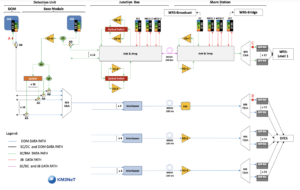1 February 2023 – Via a long-distance electro-optical network the more than 6000 optical modules of KM3NeT in the deep sea are provided with a point-to-point connection to the control station on shore. The optical layer is presented in full details:
S. Aiello et al. 2023 JINST 18 T02001 DOI 10.1088/1748-0221/18/02/T02001
Abstract:
The optical data transport system of the KM3NeT neutrino telescope at the bottom of the Mediterranean Sea will provide more than 6000 optical modules in the detector arrays with a point-to-point optical connection to the control stations onshore. The ARCA and ORCA detectors of KM3NeT are being installed at a depth of about 3500 m and 2500 m, respectively and their distance to the control stations is about 100 kilometers and 40 kilometers. In particular, the two detectors are optimised for the detection of cosmic neutrinos with energies above about 1 TeV (ARCA) and for the detection of atmospheric neutrinos with energies in the range 1 GeV–1 TeV (ORCA). The expected maximum data rate is 200 Mbps per optical module. The implemented optical data transport system matches the layouts of the networks of electro-optical cables and junction boxes in the deep sea. For efficient use of the fibres in the system the technology of Dense Wavelength Division Multiplexing is applied. The performance of the optical system in terms of measured bit error rates, optical budget are presented. The next steps in the implementation of the system are also discussed.


